Keeping betta fish with other species can be a challenge.
Betta splendens, also known as the Siamese fighting fish, has a well-earned reputation for being a difficult roommate. However, this is not to say that they must be kept as a single specimen.
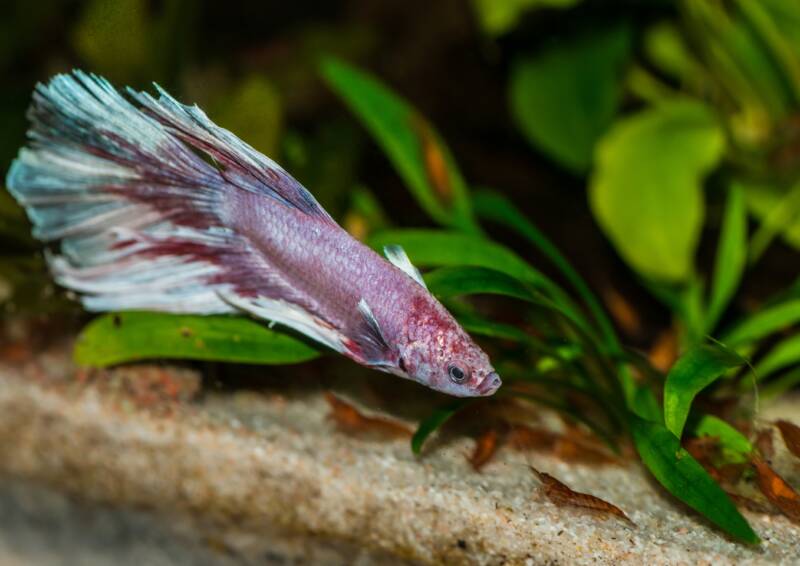
Shrimp are excellent candidate tank mates for your betta.
Not only do shrimp and bettas tend to ignore each other and thus live together peacefully, but they are also highly compatible in terms of water parameter needs.
Read on for more information on pairing bettas with shrimp along with a list of compatible freshwater shrimp species.
[toc]
Why Choose Shrimp?
Freshwater shrimp bring a unique look and are fun to watch as they move about the tank.
They are hardy and beginner-friendly, making them an excellent choice for those who are new to aquarium keeping.
These creatures are also hard-working and valuable members of a tank cleanup crew.
They are efficient scavengers that will devour detritus, leftover food, and decaying plant matter. Some will even attack algae, helping to keep the tank clean.
Tank Setup
Proper tank setup minimizes stress for your fish and reduces the chance of any aggression.
An ideal environment is optimized for both species. This means selecting a proper tank size, adding the necessary hiding places, and ensuring water parameters are steady and within the areas of overlap for your shrimp and betta.
Tank Size
To house your betta fish with shrimp, you must consider the size of your tank.
A larger tank gives each species space to call their own and reduces the chance that your betta will attack the shrimp.
A 10-gallon (38 l) tank should be your target minimum size.
Substrate
Both shrimp and bettas will do best with a soft sand or fine, rounded gravel. Avoid anything with rough edges that can harm your shrimp or fish.
Water Parameters
Set your betta tank’s water conditions as follows:
- Temperature: 76 and 80°F (24 to 26°C)
- pH: 6 – 8
- Hardness: 5 – 35 dGH
- Ammonia: 0 ppm
- Nitrites: below 0.25 ppm
- Nitrates: below 20 ppm
Regulate these water parameters. Both shrimp and bettas are sensitive to rapid shifts in water conditions, so strive to keep them as steady as possible.
Install a water heater and thermometer to control the temperature. Place your tank away from windows or heating/cooling vents, which can impact the water temperature.
Invest in a quality water testing kit and check the levels regularly. This is especially important in smaller tanks where these can shift rapidly.
Install a reliable water filtration system that is optimal for your tank size.
Plants and Hiding Places
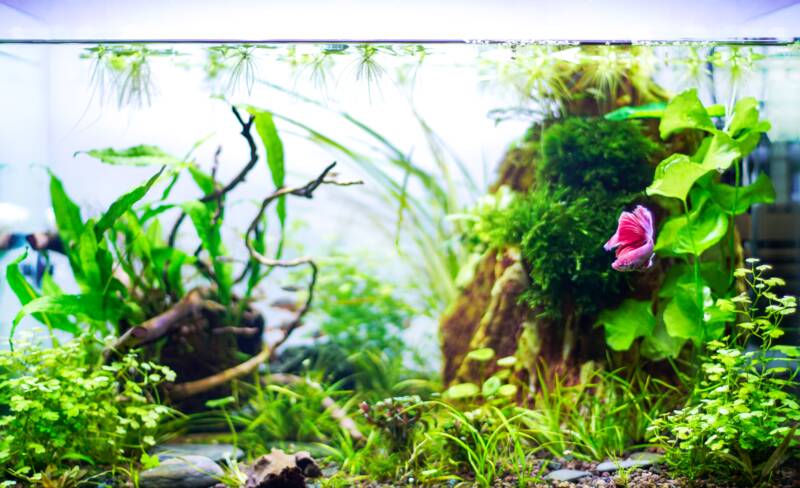
Plants and ample hiding places are a must for your betta and shrimp tank.
Your shrimp will be most comfortable in a well-planted environment that provides them with ample places to shelter.
Shelter is especially important for shrimp species that shed their exoskeletons regularly. Until their new armor hardens, they are vulnerable to predation.
Giving them a place to hide not only allows them time to grow their new shells but also reduces stress and keeps them healthier.
Live Plants
Live plants are best if you are comfortable growing them. They provide excellent hiding places for your betta and shrimp and give a natural feel to the tank.
In addition, they reduce CO2, release oxygen, and their beneficial bacteria absorb nitrates, all of which help balance the water cycle in your tank.
There are many choices for plants, depending on whether you have a high or low-light aquarium.
For high-light tanks, the Amazon sword is an excellent choice. These are easy to care for and suitable for beginner aquarists.
Anubias, hornwort, and java fern are also fantastic choices. They are the ultimate in easy care and can tolerate both low and high light levels.
Artificial Plants and Decorations
If you are not a fan of live plants, select artificial plants made from silk. The softer edges are more friendly to your betta’s delicate fins.
Similarly, when selecting decorative items for your tank, choose those with rounded edges.
Cleaning
Although shrimp are excellent members of a tank cleanup crew, you cannot rely on them solely to keep your tank clean.
Clean your tank regularly and perform a 25 percent water change weekly to keep the environment in top shape.
Feeding
A well-fed tank is a happy tank.
Feeding your betta properly is an important part of managing their aggression. A well-fed betta is less likely to seek nutrients elsewhere – in this case, by attacking your shrimp.
Feed your betta two to four betta pellets twice a day.
Although they are constantly scavenging, your cannot survive on this alone. Give them sinking foods, which your betta will tend to ignore, so that your shrimp have the nutrients they need.
Freeze-dried bloodworms are a good treat for both your betta and your shrimp. Be sure to soak freeze-dried foods ahead of feeding to prevent bloating, especially in your betta fish.
Avoid Overstocking
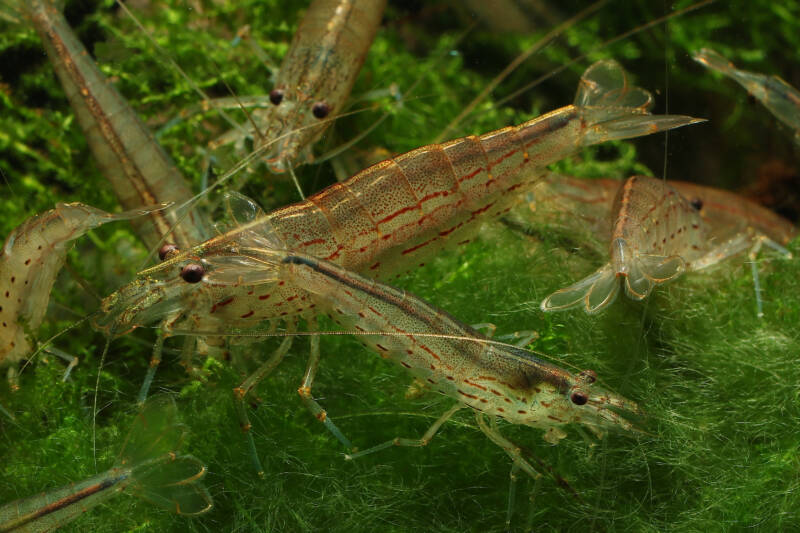
Keep in mind the size of your tank, the need for space for your betta, and the number of shrimp you add.
For smaller shrimp, those around one to two inches (2.5-5 cm) in length, plan on a stocking density of one to two shrimps per gallon.
Larger shrimp will require more space and, thus, lower stocking numbers. Exceeding stocking densities can result in a degradation of water quality.
Conversely, keeping a single shrimp of some species will result in high stress and a reduction in activity.
Aggression from Your Betta
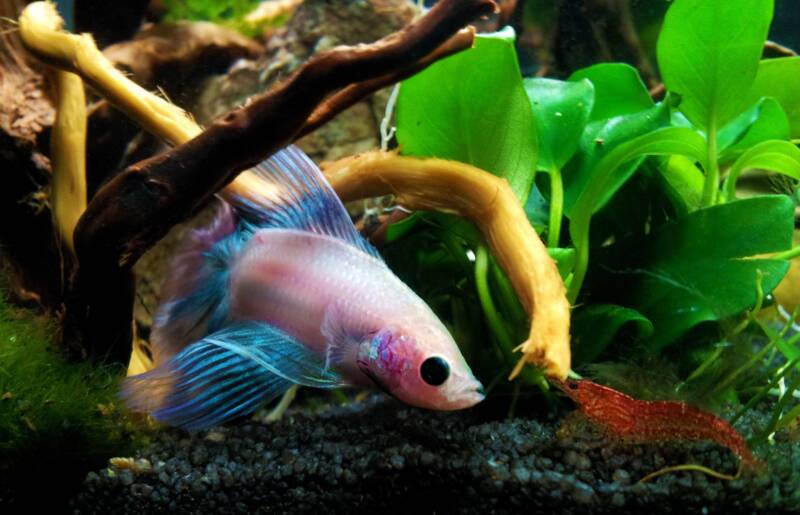
Will your betta attack the shrimp? Possibly. Often, that question comes down to the individual personality of your fish.
Bettas may be attracted to brightly colored shrimp. They may peck at them and can damage their legs or antennae.
Managing your betta’s aggression through stable water conditions, proper feeding, and a well-planned environment will all help to create the most peaceful aquarium possible.
Selecting a less aggressive female betta can also result in a more agreeable pairing.
Will Bettas Eat Shrimp?
The species listed in this article are too large in their adult size for your betta to eat.
However, if your shrimp breed, the fry may be at risk. These small shrimp may be too tempting for your betta to pass up as a ready source of nutrition.
If you wish your shrimp to breed, you may have to set up a separate shrimp tank to ensure their survival.
Compatible Shrimp Species
The following are our favorite species for pairing with betta fish:
1. Ghost Shrimp (Palaemonetes paludosus)
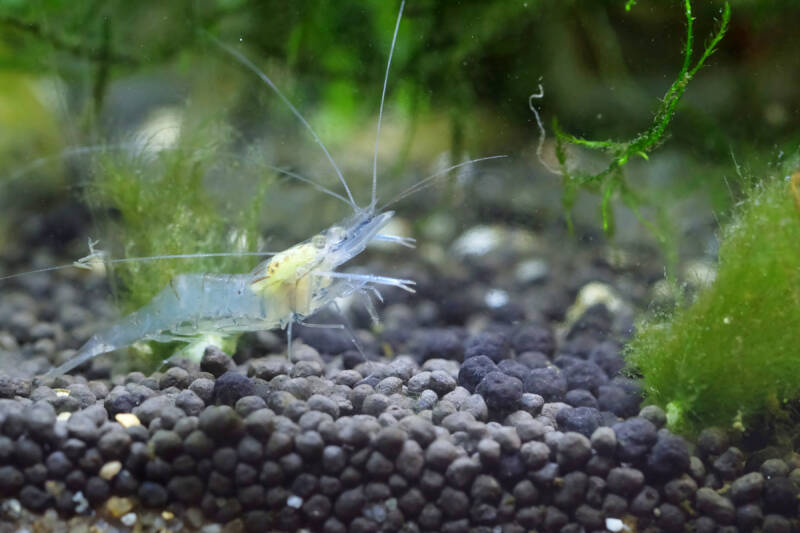
- Temperature: 72 – 82°F
- pH: 7 – 8
Ghost shrimp have unique, transparent bodies that make them a favorite with aquarium keepers. They are calm and peaceful in nature and keep to themselves.
Their natural camouflage ability makes it more difficult for your betta to target them, especially in a well-planted tank. Their adult size of 1.5 inches (4 cm) means they are large enough that your betta will not go after them as food.
These are less expensive than others, which can appeal to those new to aquarium keeping.
When planning a purchase, remember that this species should be kept in a group of at least two to four shrimp to display its most confident behaviors.
Although ghost are prolific breeders, your betta may be inclined to eat any resulting offspring.
2. Amano Shrimp (Caridina multidentate)
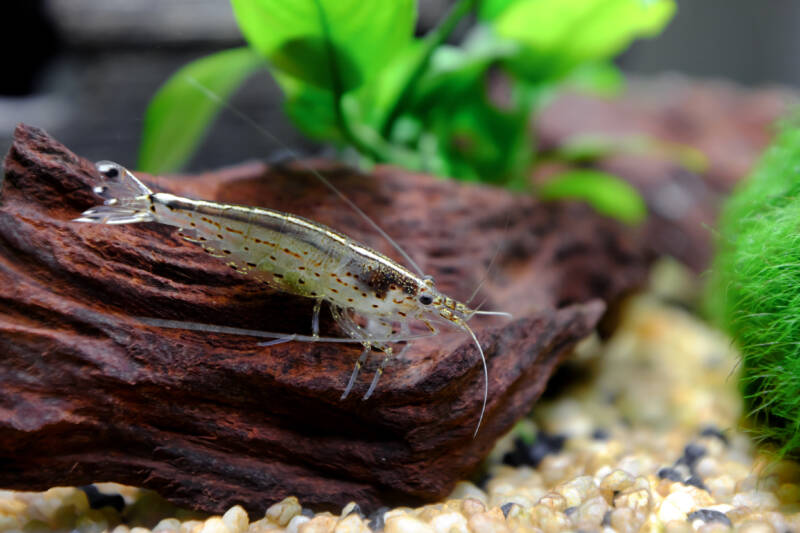
- Temperature: 70 – 80°F
- pH: 6.5 – 8
The Amano shrimp is the ultimate member of a tank cleanup crew. These efficient algae eaters and scavengers reach an adult length of two inches (5 cm),
which is a great size to pair with your betta.
They have a longer lifespan than many of the other species on this list and can live up to three years with good care.
Amano shrimp are not as brightly colored as other species, so the odds of it attracting the attention of your betta are lower.
They get along with other fish in the tank, but you may find that they tend to squabble among themselves. These shrimp form a hierarchy and may show aggression when establishing dominance.
They can also tussle at feeding time, so drop food in multiple spots in the tank.
3. Bamboo Shrimp (Atyopsis moluccensis)

- Temperature: 70 – 78°F
- pH: 6.5 – 8
This Southeast Asia native has a streaked, brown/yellow coloration and unique, fan-shaped front appendages. It uses these fans to filter food from the water, which can be fun to watch.
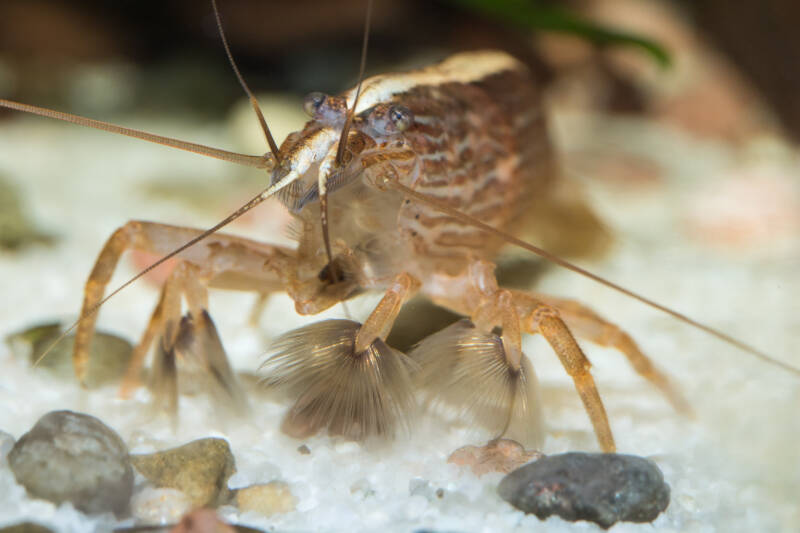
They grow larger than other species on this list, reaching three inches (7.6 cm) in length as adults.
Due to their larger size and filter feeding needs, plan on keeping only one shrimp per 20 gallons of water.
Note that this is a larger tank size than recommended for any other shrimp on this list. Long tanks are preferable to provide your shrimp with space to roam.
Live plants and a moderate current are both necessary to accommodate this shrimp’s style of feeding. Remember that your betta will not like too strong of a current, so find a middle ground for these two species.
Bamboo shrimp molt frequently, so provide plenty of hiding places.
4. Cherry Shrimp (Neocaridina davidi)
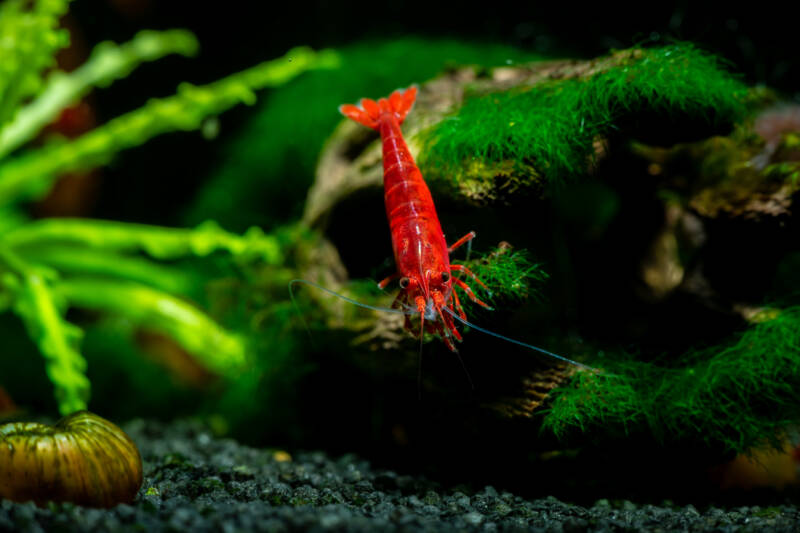
- Temperature: 57 – 84°F
- pH: 6.5 – 8
Cherry shrimp are a smaller species that bring a pop of bright red color to your betta tank.
The females of this species are the most brightly colored and largest in size, reaching up to an inch to an inch and a half (2.5 to 4 cm) in length.
Males are smaller and reach only around 0.75 inches (2 cm). The smaller size of this species means that you will want to select fully grown female specimens to place with your betta.
The bright color of this shrimp means that they may be more attractive to your betta. To reduce this unwanted attention, make sure your tank is well planted and includes plenty of hiding spaces.
Compatibility may depend on your betta’s temperament, so have a backup tank ready when introducing these two species in case aggression occurs.
Closing Thoughts
Betta and peaceful freshwater shrimp make great tank mates. Add in lush plants, and you have a natural and satisfying look and feel to your home aquarium.
Do you keep your betta fish with shrimp? If so, which are your favorite species?
